You’re looking at your DIY project plans and must make a perfect cut. But what kind of router do you need? And what’s the difference between all the basic types of routers?
This wood router buying guide will teach you the different types of woodworking routers and which is best overall for your project. You’ll also learn about accessories, safety precautions, and how to use a router.
Keep reading to learn everything you need to know about choosing the best type of router for woodworking projects!
What is a wood router?
A wood router is a handheld or stationary power tool used to shape wood and for creating deep grooves. This versatile tool is powered by a motor that spins the cutting bit and is essential in any woodworking shop. Routers can create intricate patterns, round edges, hollow out, and join wood pieces.
A wide range of router bits is available for tasks like fine joinery or inlay work. Whether a professional or a DIYer, a woodworking router is a powerful tool for creating better projects.
In 1949, ELU (now part of DeWalt) released the plunge router, allowing users to lower the spinning router bit into the material. This was a huge jump in the design of power routers, enabling precise and detailed cabinetry cuts. Since then, spring-loaded plunge routers with adjustable depth gauges have grown in popularity. Carpenters and woodworkers have relied on ELU’s MOF96 router for decades.
What are the different wood router types available?
There are three main router types in woodworking: combination, plunge routers and fixed-base routers.
- Plunge Routers: Plunge base routers allow for greater precision and control as they can be plunged into the middle of a workpiece. They are best suited for intricate joinery or projects that need precision routing.
- Fixed Based Routers: Fixed bases are common across America while a rarity in the UK. Adjusting the motor up or down changes the depth of the cut. They can make plunge cuts by tilting the router base and gently lowering it into the workpiece. Edge finishing and flush trimming are the primary uses for this router style.
- Combo router kit: The benefits of Combo kits are numerous. It combines the features of a fixed-base and plunge router for ultimate versatility. Furthermore, it is often more cost-efficient than buying both separately. Great for making dovetails, making grooves, boring holes, and carving shapes.
CNC routers for home use are also now coming onto the market. To make a plunge cut with any electric router, you will need a suitable bottom cutting router bit.
The best wood routers for different needs and budgets
The best wood routers for beginners in 2024 have high RPM ranges, accuracy and durability. Some models include a fixed-base or a plunge-base option, depending on the user’s needs.
We selected the top wood routers based on online customer reviews. These products are loved for their durable construction, ease of use, and value for money. Most models come with useful accessories like dust extraction and variable speed controls.
Highly Rated

Triton TRA001 Wood Router
Due to its many hand-held and router table features, the Triton Wood Router is the best plunge router. A powerful motor with 3.25 HP capable of speeds from 8,000 to 21,000 rpms and an automatic spindle lock. It has a soft start feature that gradually brings on the torque.
The Triton TRA001 has a multi-functional fence for more accurate cuts. This powerful router comes with 1/4 and 1/2 inch collets, giving users more versatility when using cutting bits. Variable speed controls for various materials, a micro winder for above a table. The plunge range is 0-68mm, and the plunge spring is removable for indexing cuts.
Collet Size: 1/4″ and 1/2″
RPM: 8,000 to 21,000
Weight: 6.4kg
Base: Plunge
Bosch Colt 1.25 HP GKF125CEN

The Bosch Palm Router is a best-in-class wood router for price and performance. Featuring an ergonomic soft grip body and variable speed settings for speed management. A 7 amp motor that delivers up to 16,000 – 35000 rpms for efficient routing performance. Overall, an excellent choice that offers convenience and precision in a compact size.
It offers advanced features like an electronic speed setting and integrated spindle lock. A good balance between price and reliability without breaking the bank. Bosch’s palm router also comes with two interchangeable bases for added versatility. One tool for fixed base or plunge applications – makes it ideal for any DIY project or job site task.
- Collet Size: 1/4″
- RPM: 16,000 – 35000
- Weight: 7 Pounds
- Base: Fixed, Plunge
BOSCH 1617EVSPK Plunge Router Combo Kit

The Bosch 1617EVSPK router features a 2.25hp motor for cutting speeds between 8,000-25,000. It has in-built constant response circuitry for smooth routing with torque when needed. The tool has an interchangeable fixed base and plunge base for cutting edges, making dovetail joints and more. Users may switch bases without tools using the kit’s fast clamp function. Due to its versatility and positive reviews, this device is ideal for all, even a novice.
- 1/4″ and 1/2″ collets
- RPM: 8,000-25,000
- Weight: 18.2 Pounds
- Base: Fixed, Plunge
SKIL RT1322-00 Plunge and Fixed-Base Router Combo

An LCD screen and electronics optimise power for the Skil Combo router. It has a 2.5 hp 14-amp motor, with three built-in LED lights in the transparent base for working on projects. A vacuum fitting for the plunge-base router helps remove debris effectively. Perfect for any shop, this versatile larger router can be used for most applications.
- 1/4″ and 1/2″ collets
- RPM: 10,000 – 25,000
- Weight: 14.33 Pounds
- Base: Fixed, Plunge
Perles 808E Medium Duty Router
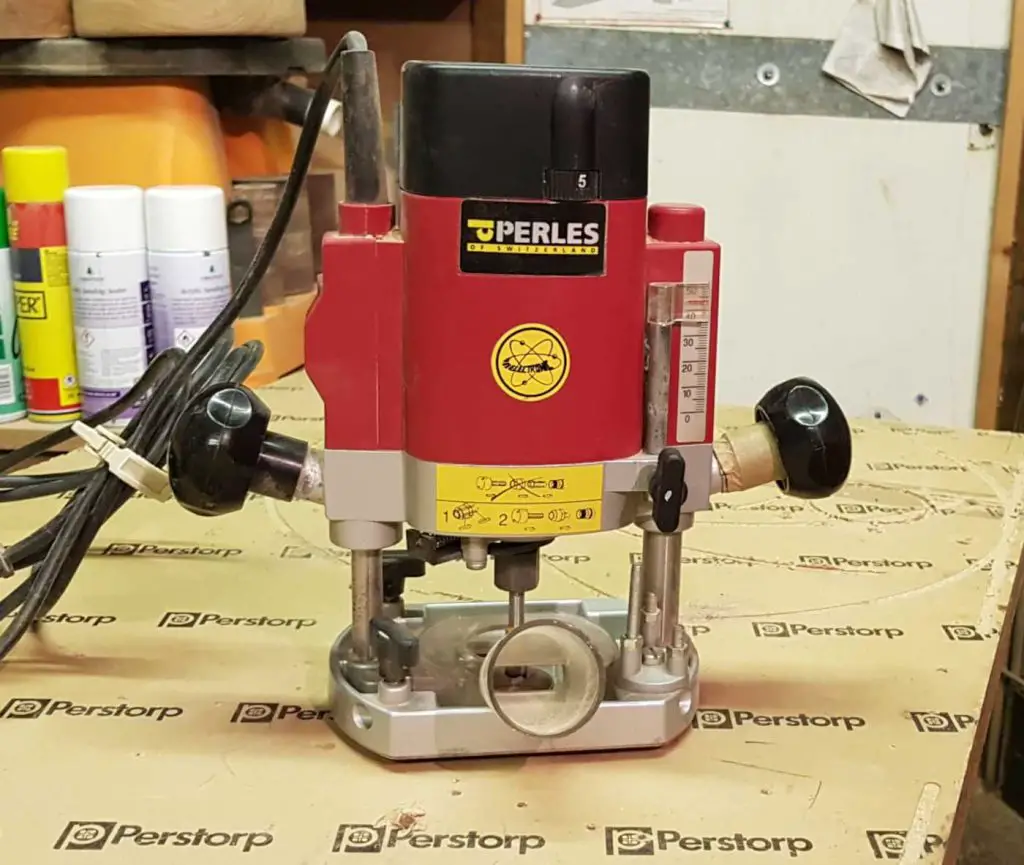
The Perles 808E router is a brand you’ve probably never heard of, but it’s been over twenty years since I bought my first. A copy of the old ELU, so the design and features have stood the test of time. Similar to the Trend T5 so, all the router accessories will fit for added functionality.
One of the notable features of the Perles 808E is its ease of use. It has a user-friendly design with ergonomic handles for a comfortable grip. Equipped with a fast depth adjustment turret that allows for precise and consistent results. The medium-duty router’s 1,010 watts motor maintains power between 9,000 – 27,000 rpms for smooth and controlled cuts.
In terms of precision, reliability, and durability, Perles’ reliable router performs admirably. The build quality is robust, contributing to the tool’s durability and longevity. I have found this corded router to be reliable (it’s my second) and has maintained performance over time.
Perles 808E Router’s performance and features justify the cost. It is supplied with a 30mm guide bush, dust extractor and an excellent micro adjustable fence.
- Collet Size: 8mm supplied, 6 and 6.35 mm (1/4″”) optional.
- RPM: 9,000 – 27,000
- Weight: 7 Pounds
- Base: Plunge
DEWALT Router Fixed And Plunge Base Kit DWP611PK

The DeWalt DWP611PK Plunge and Fixed-Base Router Combo’s 1.25 HP motor can cut at 16,000 to 27,000 rpms. It also has an adjustable turret set up for five stages and a fine tuning rod for accuracy. In addition to the 1/4″ collet and 8ft 18 gauge power cord, it also has dual LED lights to illuminate dark areas. The compact router tool comes with a three year warranty when registered with Dewalt.
- Collet: 1/4″
- RPM: 16,000 to 27,000
- Weight: 3.63 Pounds
- Base: Combined
Makita DRT50ZJ Cordless Trim Router
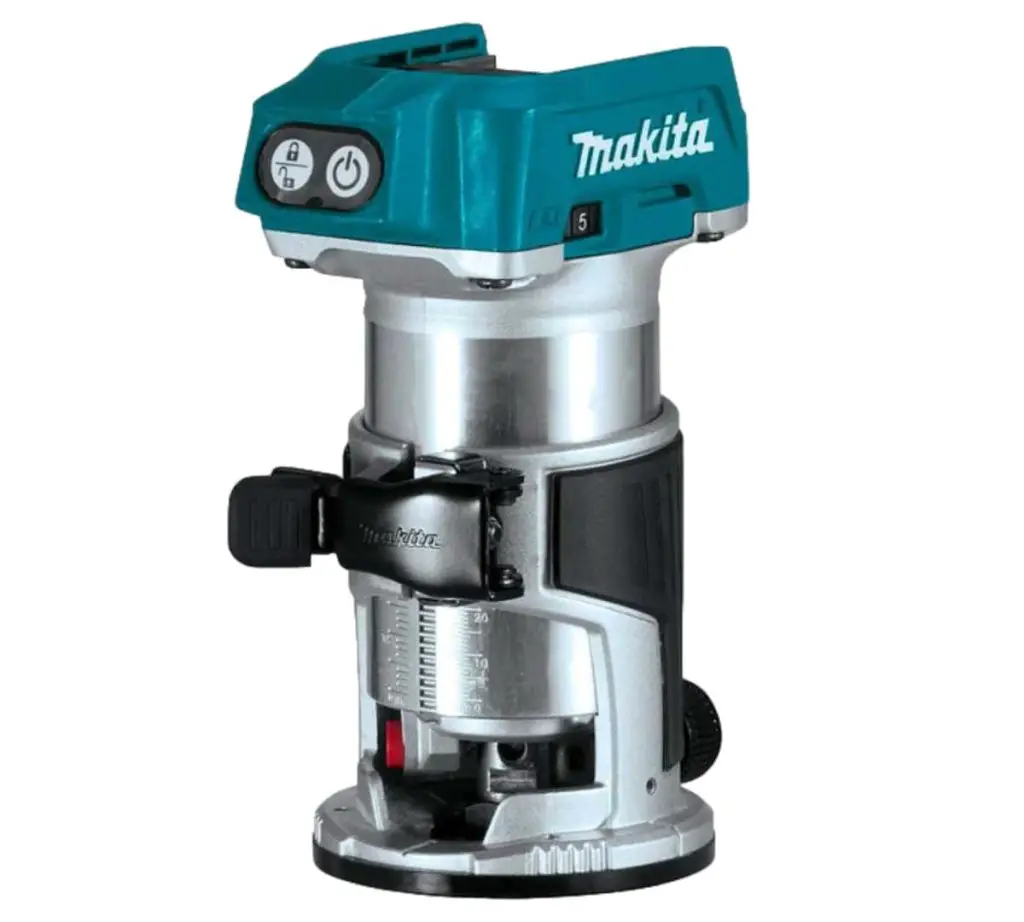
The Makita DRT50ZJ is an 18V Li-Ion brushless cordless compact router supplied in a Makpac case. A 10,000–30,000 rpm brushless electric motor and an aluminium base make it durable and accurate. When paired with the base, this tool boasts a plunge depth capacity of 0-40mm and can accommodate 3/8″ and 1/4″ collets. For safety, it uses an electronic braking system, dual work lights, and adjustable speed control.
- Collet Size: 3/8″ and 1/4″
- RPM: 30,000
- Weight: 2.1kg
- Base: Fixed
Ryobi P601 ONE+ Cordless Trim Router

The Ryobi P601 ONE+ Cordless Compact Router is an 18V lithium-ion power tool. Lithium-ion batteries are one of the latest technologies in rechargeable battery cells. They offer high energy density, long life, and short charging times. Seven different Lithium battery packs suit any ONE+ product.
Ryobi’s Cordless Router is lightweight, weighing less than 1kg without its battery. The quick release system allows for faster adjustments without using tools. There is also a micro wheel control for finer tuning accurately when needed.
- Collet: 1/4″
- RPM: 29,000
- Weight: 2.4 Pounds
- Base Type: Fixed
DeWalt DWE625KT 2300W Plunge Router
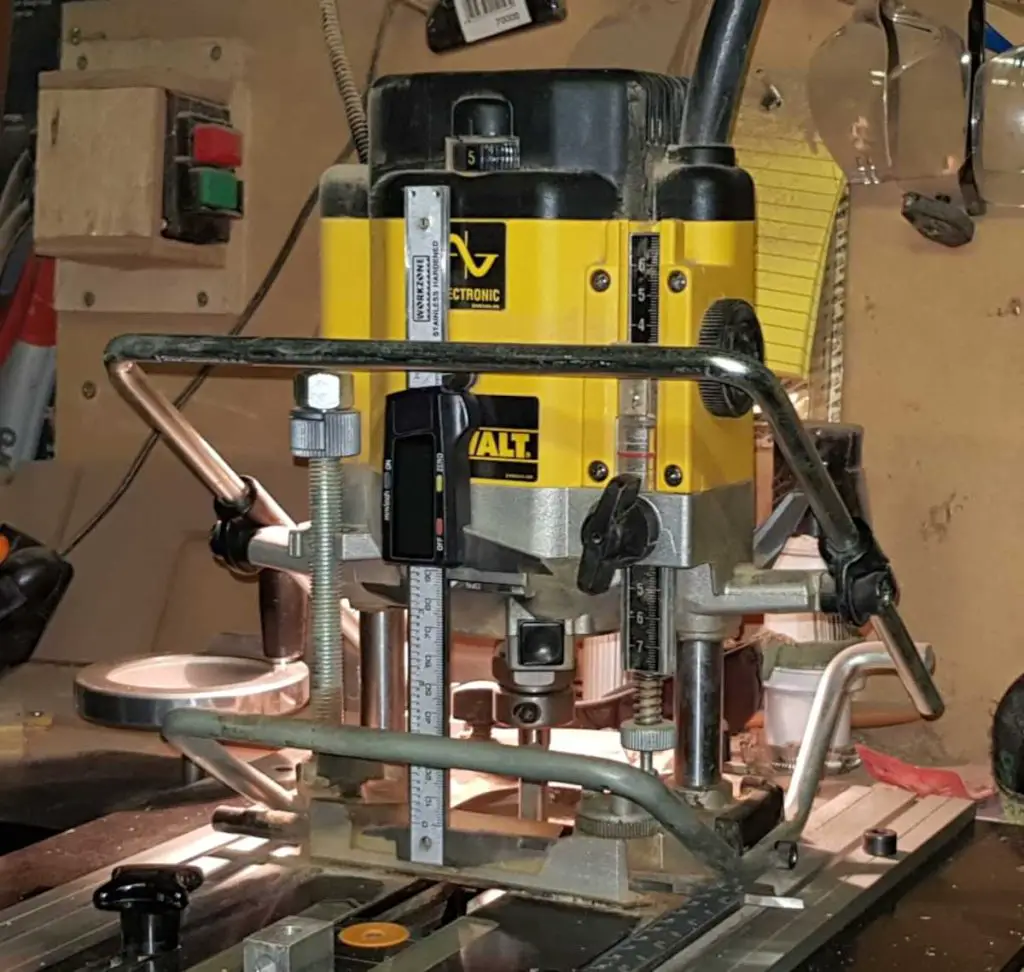
Professional woodworkers and DIYers use the DeWalt 625 high-performance router. Woodworkers have praised its accuracy, adaptability, and longevity for numerous years.
At the heart of the DWE625KT is its powerful 15-amp motor, capable of delivering up to 3 horsepower at 9,000 – 20,000 rpms. This allows for rapid stock removal and smooth cuts, even through dense hardwoods. Electronic speed control enables you to fine-tune the cutting speed to the material.
One of the most impressive features of the DWE625KT is its micro-fine depth adjustment system. This allows accurate bit height adjustment without removing the router from the workpiece.
In terms of technical specifications, the DWE625KT has a plunge depth of 2-3/8 inches and a base diameter of 6″. It weighs just over 11 pounds, making it manageable despite its potency. A good all-rounder, whether fitting a kitchen worktop or in a budget router table.
The DeWalt DWE625KT router kit is powerful and precise in a compact package. Whether you’re in the trade or a novice, this tool will impress with its performance and versatility.
- Collet: 1/2″ with an optional range of imperial and metric collets.
- RPM: 9,000 – 20,000
- Weight: 11 lbs
- Base Type: Plunge
What factors should you consider when buying a wood router?
1. Power output
Power output is the measure of how much energy a router can produce. It is measured in watts or horsepower; higher wattage means faster bit rpm. Horsepower also measures power but refers to larger motors of two horsepower +.
When using a wood router, power and control determine how easily it can cut dense materials. Working with thick hardwood requires higher wattage than thin softwood.
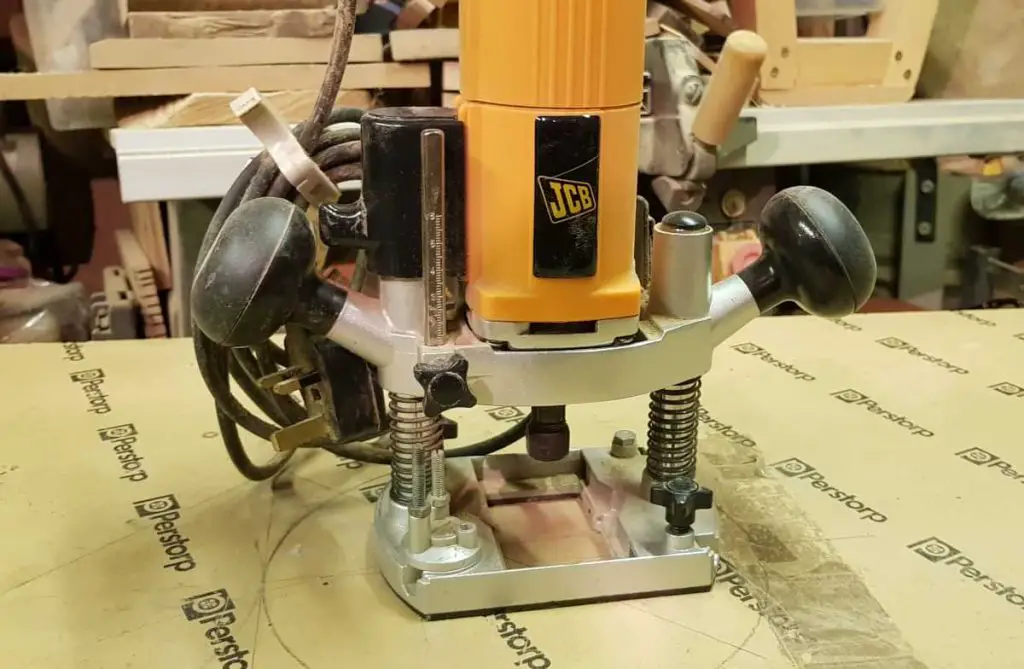
2. Router size
When choosing a router based on size, it is important to consider the motor power and collet size. Palm routers have a motor that provides up to 1-1/4 hp and use a collet that can fit 1/4″ bits. Medium-duty routers have power ratings between 1-1/2 hp and 2-1/2 hp. While heavy-duty routers have big power outputs ranging from 3 HP to 3-1/4 HP.
But compact light-duty routers are an ideal choice for beginners or precision wood routing. Mid-size routers are more versatile with larger tasks like panel raising or dovetailing. While heavy-duty routers are best for production work with large diameter router cutters.
3. Trigger system and handle variants
Some are simple on/off switches, while others may be a dead man switch in the handle. It should be easy to focus on the task without clunky or difficult-to-operate controls. There are a variety of handle styles, including D-handled, double knobs and ergonomic. D-handle bases offer a pistol grip with a locking on/off trigger switch.
Good button systems control the tool’s speed and safety measures like lock-on capabilities.
4. Variable speed control
Variable speed routers allow fine adjustments to motor speed. This is especially useful when working with different woods or bit sizes. Most modern routers have small dials that can be tweaked to select the right speed. Router speeds can vary between 9,000 – 30,000 revolutions per minute, depending on the size of bit, and the wood species.
Constant speed sensors in some quality routers adjust power they produce to maintain bit speed. Most of the biggest router tools also feature a soft start to prevent the router kick from high torque 3hp motors.
Remember, the bigger the bit, the slower the speed.
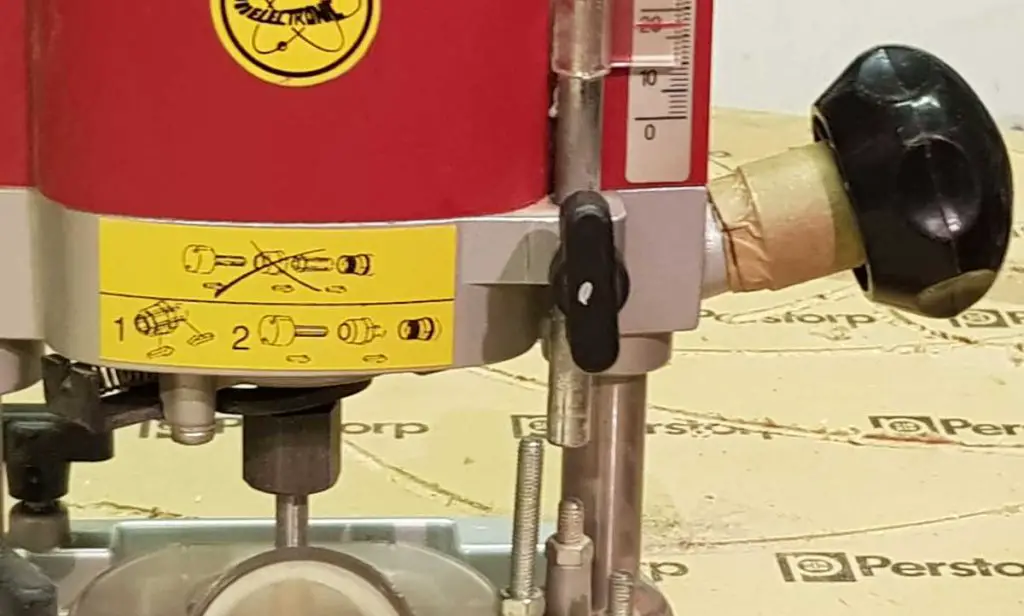
5. Depth adjustment feature
Depth stops and locking levers make up the bit depth adjustment mechanism. The metal bar slides up and is used to fine-tune the maximum depth of cut. The locking lever is used to secure the depth adjustment rod in place. Some are more sophisticated, with a rack and pinion mechanism.
6. Dust extraction port
A dust collection port that can be connected to a shop vac or dust collection system is important. This helps reduce the amount of dust created, as well as improve your working environment. Higher-end models usually have better dust collection ports than lower-end ones.
Routing will produce a surprising amount of fine dust very quickly to coat everything in the area. Wear a face mask to avoid the harmful effects of fine wood particles in the air.
7. Spindle lock system
The spindle lock holds the router bit in place so it does not rotate while changing bits or performing other tasks. Older designs and some cheap ones will use two spanners. Trying to manipulate the spanners and keep the motor body still can be a challenge 😊
When changing bits, always perform good workshop practice and unplug the router.
8. Cordless wood router options
Cordless routers have less power than their corded counterparts, but exceptions exist. You may need to purchase batteries separately, which should be charged while not in use. Smaller than corded ones, making them easier to transport.
Cordless models also come with a fixed base, which makes more precise cuts.
9. Safety features
It is important to consider the safety features offered; some of the common ones include:
- Motor cutting off when you lift the chip guard.
- Electronic braking.
- Slow-start technology.
- Good depth control.
- Easy speed adjustment dials.
- Handle-mounted triggers.
- Dead man switch.
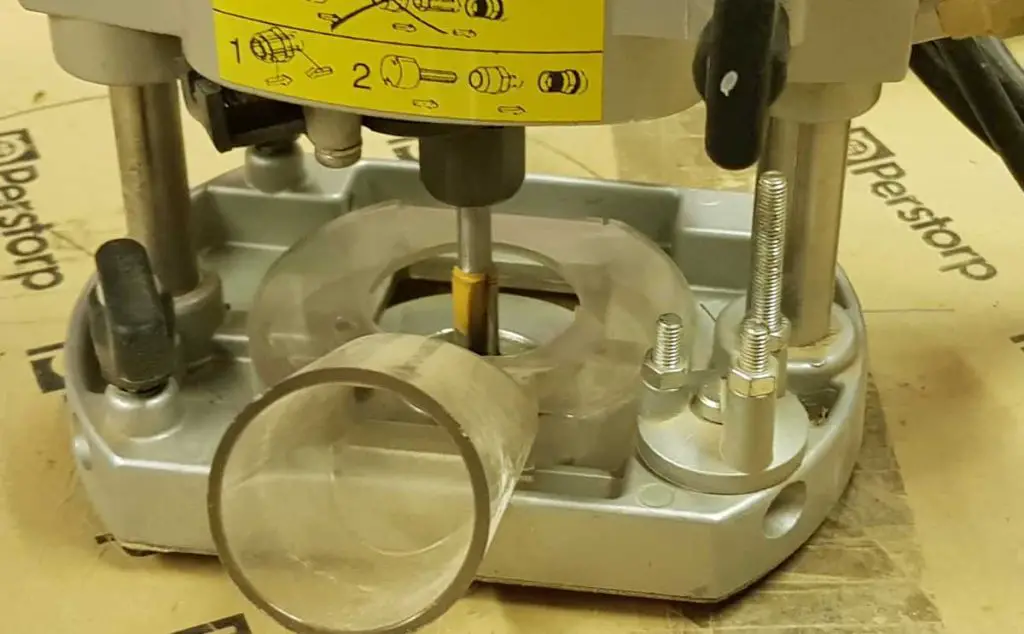
10. Warranty packages
Good wood routers usually come with manufacturer’s warranties, extended warranties, and lifetime guarantees. Manufacturer’s warranties cover any defects in materials or workmanship. While extended warranties provide additional protection beyond the standard period. Lifetime guarantees cover all defects and malfunctions for the owner’s lifetime.
FAQ
Q. How do wood routers work?
Wood routers are handheld or table mounted power tools that use a motor to spin the cutter bit, which cuts into the wood. The router can carve intricate patterns, round off edges, and hollow out a mortise. It can also be used to combine two pieces of wood for cabinet making purposes.
To use a router properly, it is important to understand its parts and how they work together. The motor provides power to rotate the bit at high speeds so it can cut into the wood easily. The base of the machine helps stabilize it during use. Most routers also have adjustable guide fences that help to route grooves or shape edges.
Q. What is the best wood router for me?
The best wood router for you will depend on your specific needs and budget. When choosing a wood router, it is important to consider the intended use, project size and budget. A medium model with less power may suffice for decorative inlays or template guides. Larger projects may need more power or better build quality than cheaper models.
To simplify, compare models by horsepower (HP), speed range (rpm), brand, and warranty. Pay attention to ergonomics that make using the tool more comfortable over time. When making your final choice, look for any extra accessories that may be useful down the line.
Q. What kind of router bit should I use for my woodworking project?
Choose a router bit for your carpentry project based on its type of material (high-speed steel or carbide) and its design function (edge or non-edge). You should also consider the shank’s diameter and whether or not it fits your router’s collet nut.
Q. What is the maximum cutting depth of a wood router?
The maximum cutting depth of a wood router is the maximum distance it can cut into a material. This depends on the design of the unit and usually ranges from 2 to 3.5 inches for most routers.
Since plunge routers plunge deeper, they provide more depth diversity. Speed is often given in Maximum Rotations per Minute (Max rpm), with faster rpm leading to cleaner cuts. No Load rpm is the top speed without material in its path.
What accessories are available for wood routers?
Wood routers may be fitted with accessories to improve performance. These include:
- Edge guides – An edge guide is helpful to ensure straight cuts and trimming edges. They can be adjusted for different sorts of work.
- Profile cutters – Profile cutters are used for decorative edge shaping, grooves and other effects in wood surfaces. They come in different forms depending on the desired design effect.
- Clamps – Clamps are used to hold things down while you work on them with power tools. They also help stop movement during operation, which ensures accurate results every time.
Enhance your woodworking tasks with the right wood router
In conclusion, choosing the right wood router for your needs can significantly enhance your woodwork expertise. We have examined different types of routers, highlighting their features and applications.
You can decide on your specific needs by learning their functions and choices. The best router for woodworking can elevate your craftsmanship and finishing techniques to professional levels. For beginners getting into woodwork, we recommend a plunge or a compact model. Consider models from brands such as Dewalt, who have proven their quality over time.




